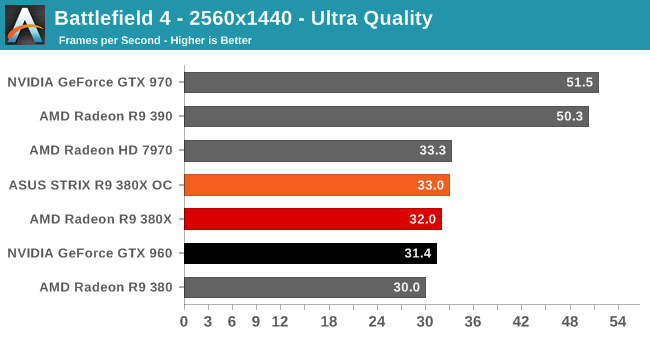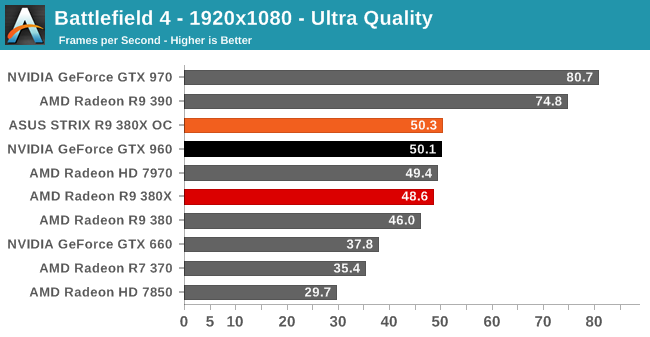The AMD Radeon R9 380X Review, Feat. ASUS STRIX
by Ryan Smith on November 23, 2015 8:30 AM EST- Posted in
- GPUs
- AMD
- Radeon
- Asus
- Radeon 300
Battlefield 4
Kicking off our benchmark suite is Battlefield 4, DICE’s 2013 multiplayer military shooter. After a rocky start, Battlefield 4 has since become a challenging game in its own right and a showcase title for low-level graphics APIs. As these benchmarks are from single player mode, based on our experiences our rule of thumb here is that multiplayer framerates will dip to half our single player framerates, which means a card needs to be able to average at least 60fps if it’s to be able to hold up in multiplayer.


Though not doing poorly, Battlefield 4 has not been a game AMD’s products have excelled at lately. Case in point, at 1080p even the referenced clocked R9 380X can’t unseat the GeForce GTX 960; it takes the ASUS factory overclock to do that. Overall while the 380X is on average 10% faster than the GTX 960, as we’ll see as we work through our games it will not take the top spot in every single game, so this will not be a clean sweep.
Meanwhile Battlefield 4 is a good example of why AMD wishes to focus on 1440p, despite the fact that Tonga is going to come up a bit short in overall performance. As we’ve seen time and time again, AMD’s performance hit with resolution increases is less than NVIDIA’s, so a loss for the R9 380X at 1080p is a win at 1440p. There are a few cases where the R9 380X is fast enough for 1440p, but by and large you’d have to take a quality hit to reach the necessary performance. So unfortunately for AMD this bulk of the focus on the R9 380X is going to be at 1080p.
As for comparisons with past cards, we’ve gone ahead and thrown in the Radeon HD 7850 and the GeForce GTX 660, 2GB cards that launched at $249 and $229 respectively in 2012. Part of AMD’s marketing focus for the R9 380X will be as an upgrade for early 28nm cards, where the R9 380X is a significant step up. Between the greater shader/ROP throughput, greater memory bandwidth, and doubled memory, the R9 380X is around 82% faster than the 7850, which traditionally is around the area where a lot of gamers look for an upgrade.
Finally, at the other end of the spectrum, it’s worth pointing out just how far ahead of the R9 380X the R9 390 and GTX 970 are. In the introduction we called them spoilers, and this is exactly why. They cost more, but the performance advantage of the next step up is quite significant.










101 Comments
View All Comments
Samus - Monday, November 23, 2015 - link
I had the Asus GTX970 Turbo and it had the grindiest ball bearing fan I've ever heard. It brought me back to the Athlon's YS Tech and Delta days. The "Titan" cooler on my old GTX770 was virtually silent in comparison.So Asus has their duds, but the Strix seems to be a great cooler if you don't need a blower...but many of us do. In a bit a shame toward Asus, I replaced their Turbo with a PNY 970 (also a blower) and the PNY feels cheaper, but cools better and makes less noise.
evilspoons - Tuesday, November 24, 2015 - link
Don't get me wrong here, I really like ASUS stuff - but they have let me down several times on cheapo video card cooling systems. Nasty sleeve bearing fans on half-height Radeon 6580s that vibrate then seize, which was really cheeky considering the box had a "high quality fan omg!!" thing as part of its marketing material.Ended up replacing the half-height card with a passively cooled one - and a nearby 80 mm case fan - so I couldn't have a crappy onboard fan, since every other card on the market seemed to be carrying the same stupid POS fan. I couldn't even spend more to get a better one!
Margalus - Monday, November 23, 2015 - link
I wouldn't get anything other than a EVGA cooling system.. I have the ACX 2.0 verions of a 970 and a 980 ti, and they are really fantastic... lolSamus - Tuesday, November 24, 2015 - link
EVGA is great, but they don't make Radeon cards. It's important to point out, as well, that EVGA is actually NOT NVidia's OEM partner. PNY is. PNY makes a ton of cards based off NVidia's reference designs, which I think are the best. The Titan cooler used on reference 770/780/970/980 GPU's, specifically the vapor-chamber variant, is unsurpassed by any other partners'. That's why almost every partner makes at least one variant of these GPU's with the Titan cooler. They don't make many, because the rumor is NVidia charges $30 for the vapor chamber cooler and it is more expensive to manufacture the cards because of the installation (GPU binding) technique.But EVGA has probably the best, easiest to deal with warranty. Unfortunately I've had to use it.
tamalero - Tuesday, November 24, 2015 - link
If use Sapphire's DualX and triX for the AMD camp imho.I'm still with my trusty 7950 dual X OC. and works wonders!
just4U - Friday, November 27, 2015 - link
From what I understand Sapphire started with the vapor chamber type cards on a few of their Radeons 6 years ago.. Interesting that Nvidia went that route. I'd never heard of any other company doing it before and didn't know they had that on their high end coolers..maecenas - Monday, November 23, 2015 - link
Fair enough, I am generalizing based on an observation pool of 2, which I shouldn't do, but I really enjoy having a silent GPU that doesn't go over 65C! It seems that cooling technology has progressed across the board, which is great news for everyone.BurntMyBacon - Tuesday, November 24, 2015 - link
@maecenasI agree they have a nice cooling system. They may even have the best at the moment. That said, I do believe they have some good competition in this area. MSI impressed me with their Twin Frozer design back before Asus had a DirectCU design out. They've been constantly improving since then. Saphire (much as I dislike them) released some very appealing vapor chamber designs. EVGA had pretty decent blower coolers, but nothing really standout until their second revision of their non-blower design (ACX 2.0). The ACX 2.0+ is copper heaven. I don't really favor designs that just throw another fan at it without really giving much thought to the heatsink design like Gigabyte's Windforce cards. I feel like MSI set the bar with their original Twin Frozer cards and since then, MSI, Asus, Saphire (sigh), and now EVGA have been vying for dominance in the cooling department.
just4U - Friday, November 27, 2015 - link
Strix is nice but MSI's cooling solution is just as good.olivaw - Monday, November 23, 2015 - link
Did I miss the GTX 960 review???